 |
| 友情链接 |
 |
|
| |
 首页 -> %EF%BF%BD%EF%BF%BD%EF%BF%BD%EF%BF%BD%EF%BF%BD%EF%BF%BD%EF%BF%BD%EF%BF%BD%EF%BF%BD%EF%BF%BD%EF%BF%BD%EF%BF%BD%EF%BF%BD%EF%BF%BD%EF%BF%BD%EF%BF%BD%EF%BF%BD%EF%BF%BD%EF%BF%BD%EF%BF%BD%EF%BF%BD%EF%BF%BD%EF%BF%BD%EF%BF%BD 首页 -> %EF%BF%BD%EF%BF%BD%EF%BF%BD%EF%BF%BD%EF%BF%BD%EF%BF%BD%EF%BF%BD%EF%BF%BD%EF%BF%BD%EF%BF%BD%EF%BF%BD%EF%BF%BD%EF%BF%BD%EF%BF%BD%EF%BF%BD%EF%BF%BD%EF%BF%BD%EF%BF%BD%EF%BF%BD%EF%BF%BD%EF%BF%BD%EF%BF%BD%EF%BF%BD%EF%BF%BD |
 |
 |
| Intellectual Property, Innovation and Investment in Clean Energy: Exploring U.S.-China Perspectives |
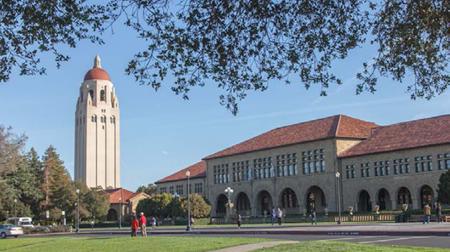 Second Joint Workshop on Intellectual Property in the Second Joint Workshop on Intellectual Property in the
U.S.-China Clean Energy Research Center (CERC)
February 26-27, 2013
Stanford, California
Workshop Summary
Prepared for the U.S.-China Clean Energy Forum
by Joanna Lewis1
1 Joanna Lewis is assistant professor of Science, Technology and International Affairs at Georgetown
University's Walsh School of Foreign Service, Washington, DC, and observer of the workshop.
2 More information about the U.S-China Clean Energy Research Center is available at http://www.us-
china-cerc.org.
May 8, 2013
On February 26-27, 2013 at Stanford Law School, the Stanford University Steyer-Taylor Center
for Energy Policy and Finance, the U.S.-China Clean Energy Forum, and the China Science and
Technology Exchange Center co-hosted the second workshop for participants in the U.S.-China
Clean Energy Research Center (CERC) to examine and discuss issues related to intellectual
property in clean energy collaborations.2
This workshop was a follow-up to the first IP workshop that took place in Haikou, China in
March 2012 and expanded upon many of the themes raised there, particularly differences in
Chinese and U.S. laws for the protection of intellectual property. This meeting also presented new
case studies of firms’ experiences navigating IP landscapes to protect their clean energy
inventions in both countries. Also new to this workshop was an opportunity for CERC
participants to ask specific questions of the IP professionals present related to their ongoing
research collaborations.
Summary of Key Workshop Findings
Several key themes arose during the workshop presentations and discussions, which are
summarized below.
. China has more individual patent owners than the United States, and this has implications
for innovation and IP protection. There are increasingly incentives for individual
researchers to benefit directly from their inventions, which was not the case in the past.
However, the large number of owners in China means there is also a risk of abusive
litigation from non-practicing entities.
. China has enhanced its own IP protection primarily due to an increased demand for
protecting domestic innovations.
. There are many examples of innovations from elsewhere being commercialized in China,
particularly in pharmaceuticals, but this is increasingly true for clean energy as well.
. While U.S. PTO programs that aim to make it quicker and cheaper and easier to patent
clean technologies can be useful (like the fast track system, green technology pilot
program or patents for humanity programs), there are still real problems after the patent is
issued in the form of excessive ligation or “patent thickets.”
. Non-practicing entities (NPE or “patent troll”) are companies entirely in the business of
lawsuits, primarily asserting patents they’ve acquired from another party. NPEs file over
half of all patent lawsuits in the United States. They frequently target startups that cannot
defend themselves from litigation.
. NPEs are a significant issue in the United States; however, they may find China a more
difficult legal environment to win cases because China’s courts require the patent holder
to show the damages they suffered.
. Many firms are concerned about bringing “Easy IP” to China, even if it could have
valuable applications there. IP that is easier to copy is frequently also easier to enforce in
court since it easier to provide evidence to prove the infringement.
. While trade secrets can be difficult to protect because they are easy to lose, there are
many simple actions firms can take to prevent loss, including disabling the use of USB
drives or monitoring emails for large attachments.
. Trade secret protection presents a particular challenge in the Chinese context, due to a
lack of mature legal protections for trade secrets. This is a problem because many
companies rely on trade secret protections instead of patents when they want to keep their
invention secret.
. Agreeing to the terms of an IP agreement may take time, but it worth the time upfront to
come to full agreement prior to beginning work in order to avoid misunderstandings,
disputes, or at a minimum, having to go back and reopen an agreement for negotiation.
. It is as important to be selective in choosing your business partners in a bilateral venture
as it is in undertaking a domestic venture. You want to make sure that your interests are
aligned, and once in negotiations, make sure you have mutual understanding.
. There are many reports of misperceptions between Chinese and U.S. firms due to cultural
differences, and a lack of understanding of each other’s IP rules and legal systems. This
can lead to differences in understanding of terminology being discussed that may have
different legal interpretations and different cultural contexts (such as “exclusivity” and
“technology transfer,” among others).
. Collaboration may be crucial for the survival of small companies, particularly if other
firms bring IP infringement cases against them. Collaboration was also identified as
being crucial to driving down costs and sharing RD&D costs.
. There are major differences in the discovery process in China and the United States.
While many believe the process is too cumbersome in the United States, in China it is
believed to be far too brief. Although in the United States parties can be compelled to
produce information that is adverse to their case, the same is not true in China.
. Joint Ventures (JVs) come with a unique set of IP protection concerns. The dual
ownership structure makes it even more important to work out IP arrangements between
the parent firms, planning ahead for how to handle things when/if the JV dissolves.
. There is increasingly extensive coordination between the U.S. and Chinese patent offices
which is being reflected in a gradual increase in consistency between the two legal
systems. In addition, the United States Patent and Trademark Office (USPTO) and the
State Intellectual Property Office of the People’s Republic of China (SIPO) Patent
Prosecution Highway (PPH) pilot program began on December 1, 2011 and streamlines
the patent application process for inventors filing in both systems.
. “Innovation parks” are being used in China to promote international R&D cooperation
with over 10 parks established to date, including the China-U.S. (Wuxi) Science and
Technology Innovation Park, and this model could be expanded in the future.
. The CERC should be more widely understood in both countries as it may serve as a
model in addressing IP in bilateral relations and its work on IP has value in cutting
through the “fog of misunderstanding” around IP issues.
Summary of Presentations
Summaries of the presentations made by the participants from the U.S. delegation are described
below. For further details the original presentations are available on the CERC website for
review.
Day 1
1. Welcome
Dan Reicher from Stanford University began the conference by welcoming participants. He noted
that U.S. Energy Secretary Steven Chu would soon be returning to Stanford as a professor.
Remarking that the clean energy sector had transformed from a collection of small companies to a
group of truly multinational players, Reicher said that allowing this globalization to continue,
rather than fighting it, will be a key element of this sector’s future growth. Since the protection of
intellectual property (IP) will be important for this to happen, IP issues need to be worked out in a
constructive, forthright way. He hoped this workshop would promote constructive discussion of a
contentious issue with hard-hitting implications, and with important implications for our
companies’ and countries’ competitiveness. He noted that Stanford has a tradition of encouraging
debate about important ideas, and that he hoped the participants could use this workshop to talk
frankly, and not just about legal theories but about business realities; and not just about IP but
about the broader relationship between the United States and China on clean energy. He hoped
that this “talk” could be turned into action, and that participants would come out of this meeting
with suggestions for real resolutions to IP problems.
Dennis Bracy from the U.S.-China Clean Energy Forum welcomed participants to the meeting
and thanked the organizers for many months of preparation for this workshop. He commented
that while “IP” usually refers to “intellectual property,” it could also stand for “innovation
promotion,” since the two are related, and innovation promotion is what we are trying to do in the
context of the CERC, as well as furthering our common goals to promote clean energy
technology development.
Bi Gang, the Deputy Consul General of San Francisco, noted that climate change has been a
critical part of U.S.-China joint efforts since turn of the century. He called the CERC an
important opportunity to deepen bilateral cooperation in emissions reduction, clean energy and
environmental governance, and mentioned that it had become a highlight of U.S.-China
cooperation. Recalling the November 2009 Presidential launch of CERC, he noted that the teams
have since joined R&D forces, worked closely together under the CERC framework, and
achieved much progress. The fact that industries, universities and research institutions had joined
consortia as equal partners was unprecedented, and marked the start of a new phase in bilateral
cooperation. These actions enhance joint efforts on climate issues and therefore contribute to the
United Nations Framework Convention on Climate Change’s call for strengthening technical
cooperation between countries. He commented that cooperation under CERC reflects our shared
interests in seeking innovative solutions and developing major new clean energy innovations, as
well as a friendly cooperative spirit between our two countries.
2. Opening Remarks

Energy Forum
Dennis Bracy introduced the U.S. and
Chinese CERC Directors. He noted that the
CERC model did not require a new building,
but instead taps into the greatest minds to
create a virtual organization. Coordination of
such an organization, however, is no small
task, particularly when it merges languages,
cultures, and hundreds of scientists. This
coordination is accomplished by Robert
Marley and Liu Zhiming.

Robert Marlay, the U.S. CERC Director from the
Department of Energy, welcomed all participants, noting
that the large number of participants that came over from
China (55) indicated the importance of the topic and the
seriousness of their commitment. Dr. Marlay spoke of
CERC’s amazing lineage as a Presidential initiative,
chartered by the two most senior science officials in the
United States and China, Wan Gang and Steve Chu. Organized under a novel government-to-
government agreement, the CERC includes $150 million jointly pledged over five years, and an
IP annex designed to facilitate the allocation and management of IP.
Dr. Marlay reminded us that the United States and China are the world’s two biggest economies
and the biggest consumers and producers of energy. We depend heavily on coal, import much of
our oil, and are responsible for about 40% of the world’s greenhouse gas emissions. Since much
of our infrastructure is yet to be built, it can be influenced by what we develop in the CERC. Both
countries see scientific discovery and innovation as a way to inspire economic growth and
improve the quality of life of our citizens, and we both have great capacities for solving problems,
so we have many reasons to work together. The main premise of CERC is that we can tackle
these joint challenges faster and more cheaply if we can figure out new ways to work together.
The CERC has three tracks, focusing on different technology areas, and all the CERC directors
were in attendance at this workshop. Dr. Marlay stated that the CERC currently consists of 88
individual projects within these three tracks, and that almost all of these projects are joint
collaborations between U.S. and Chinese researchers, nothing that the goal is for all projects to be
joint, and to be “collaborative,” and not just “cooperative.” He estimated that 1,100 researchers
in the U.S. and China were supported by the work of the CERC, and that 100 partners were either
contributing funds or directly performing research. He noted that there are already signs of
success across these projects, as reported at a recent meeting in Washington. He also noted that
more and more industrial partners and business ventures wanted to join the CERC, and that many
were offering funds or in-kind contributions to join. In addition, other countries are beginning to
take notice of the CERC and are looking to build on this model.
Dr. Marlay emphasized that support of the CERC from the highest levels of the two governments
and particularly an endorsement of the IP protection framework both allows for oversight and
encourages compliance. In addition, he discussed there being real advantages to doing
cooperative work under a government-to-government agreement, and that protecting IP ensures
everyone brings their best information to the collaboration. He mentioned that four independent
evaluations of the CERC had been conducted, including one by the National Center for Science &
Technology Evaluation of China (NCSTE) sponsored by the Ministry of Science and
Technology. He said that the evaluations had called CERC a “milestone initiative” that is both
pragmatic and win-win, and that it “enables a new kind of relationship built on mutual
understanding and trust,” referring to the Technology Management Plans (TMPs) as
“groundbreaking.”
He concluded by asking the workshop participants to consider how this conference can build on
the one in Hainan; whether we can strengthen the practice of IP and it’s protection, and whether
we can apply the CERC model without high transaction costs. He also asked whether, when we
face serious challenges, our agreements will hold up, or if there are sticking points that we need
to fix. Finally, he asked whether the CERC IP framework might be extended to other endeavors
in science and international affairs.

COUNSELOR LIU ZHIMING, CHINA CERC DIRECTOR
Liu Zhiming, the China CERC Director from the
Ministry of Science and Technology (MOST),
welcomed the workshop participants, thanking Stanford
and the China Technology Exchange Center. Noting that
the Hainan conference had contributed to fruitful
communication and exchanges on IP, he said that he
hoped good progress could continue in this area.
Providing an update since the last workshop, Counselor Liu noted that collaborations have been
strengthened and more importance has been attached to IPR based on the TMP’s foundation, and
he called for an expansion of the consortia and of the outputs of R&D. As we jointly face the
climate change challenge he hopes that the CERC will deepen our understanding and facilitate a
model for IP protection and joint research in clean energy.
3. Opening Remarks on Innovation and IP Protection

MA WEIYE, DIRECTOR GENERAL OF THE
DEPARTMENT OF PATENT ADMINISTRATION IN
THE STATE INTELLECTUAL PROPERTY OFFICE
OF THE PEOPLE’S REPUBLIC OF CHINA
Ma Weiye, Director General of the Department of
Patent Administration in the State Intellectual
Property Office of the PRC, spoke about the status
and motivations for IP protection in China.
First, he explained that China stresses IP protection as part of Former President Hu Jintao’s plan
for an innovation-driven path for the country. He noted that IP and innovation are related, since
IP is the result of innovation, and that if IP is not protected a lot of innovators will lose their
passion to innovate. Therefore he believes that China has enhanced its own IP protection
primarily due to its own domestic innovation needs, rather than due to international pressure.
Second, he discussed China’s emphasis on judicial and administrative enforcement of IP
protection, noting that administrative remedies were often more effective than judicial. He noted
that beginning in October 2010 the government began to crack down on IP infringements.
Third, he noted some achievements within China’s IP protection system, as measured by cases of
infringement tried in court and damages paid. He also noted that the volume of patent
applications has risen steadily in China as innovators believe that domestic IP protections can
help to protect their innovations.
Fourth, he commented on future directions in Chinese IP law, including a need to continue to
deepen and enhance protections. He predicted that judicial protection would be expanded, and
administrative enforcement would be improved. He also noted that with such enhanced IP
protections, China would likely see an increase in cases of infringements. He ended by observing
that an enhanced IP system in China could help lead U.S.-China collaborations involving IP.

MARK A. LEMLEY, DIRECTOR OF THE STANFORD
PROGRAM IN LAW, SCIENCE AND TECHNOLOGY
Mark Lemley, a Professor at Stanford Law School
professor and an attorney with Durie Tangri LLP,
mentioned recent developments in the United States
designed to promote clean energy innovation, including
the U.S. Patent And Trade Office’s (PTO) Green Energy
Pilot Program and the Patents for Humanity Program. He
said that while both programs aim to make it quicker and
cheaper and easier to patent clean technologies, some of the real problems occur after the patents
are issued, particularly related to ligation, noting that patent litigation has been expanding in
many sectors in the U.S. (though primarily outside of the energy technology sector). While most
lawsuits in energy are from companies that enforce a patent only once, in other sectors there are
multiple lawsuits from multiple corporations, leading to a “patent thicket” or complex web of
lawsuits where multiple companies are suing each other.
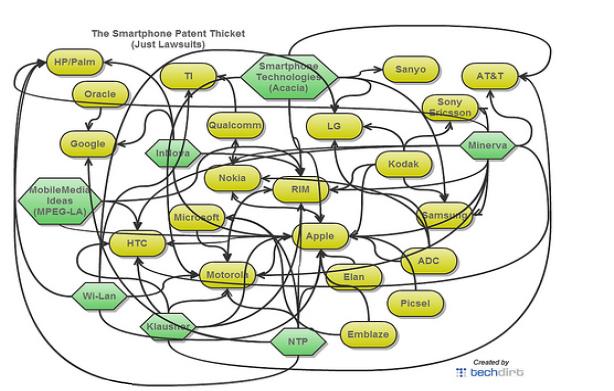
Fig 1. The Dangers of a Patent Thicket.
Source: Presentation given by Mark Lemley, Stanford Law School (original image from Techdirt.com).
Another issue is that of “patent trolls,” or companies entirely in the business of lawsuits,
primarily against patents they’ve acquired from another party. The United States has made
modifications to the law recently to make this somewhat more difficult.
eBay v. MercExchange Case (U.S. 2006) granted injunctive relief to patent trolls trying to shut
down the technology. Since ITC still has the power to grant injunctions to patent trolls, growth of
filings has been substantial. Patent trolls are responsible for more than half of assertions made in
the ITC. While software patents are the primary target, trolling is common in most industries
where too many patents have been granted on too simple or too many elements of the invention.
Patent trolls increasingly target startups, since they are generally not able to defend themselves
against litigation.
Lemley clarified that despite all of these problems, he is not suggesting that patents or patent
litigation are bad ideas. They are important for the role they play in providing startup capital, and
provide a valuable signaling mechanism. Economic espionage and copying are real threats that
they can protect against. But the solution cannot only be obtaining more patents more cheaply. It
is also necessary to make sure that patents promote technology transfer and the development of
innovation, and not impede it as they have done in software industry.
In the Q&A session, panelists asked how China is dealing with the problem of patent trolls. It was
suggested that there is even more of a risk of abusive litigation from non-practicing entities in
China because there are even more inventors, although this has not become a major problem yet.
If patent trolling isn’t illegal there isn’t much China can do administratively, though the judges
may be able to influence this.
Also discussed was the topic of whether different sectors or types of inventions had different
manners of protecting IP due to different characteristics. Lemley mentioned that for inventions
which are hard to copy, or rely on process expertise and trade secrets, the inventors sometimes
delay or forego patent protection in favor of keeping their invention secret for a period of time.
For that to work, he said that we need robust protection of trade secrets in all countries concerned.
The costly nature of an invention may make it harder to imitate and reduces risk of copying, but it
also means the inventor must make a substantial investment in the technology, and requires some
investment in the technology to recoup their investment.
4. Panel 1: Bringing IP from the United States to China
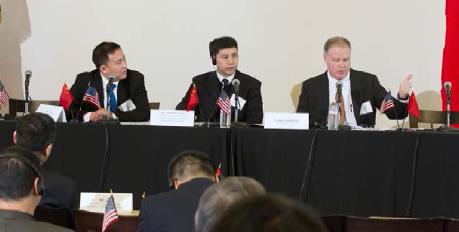
(LEFT TO RIGHT) HE JING,
DR. ZHAO GANG AND
FRANK LANDGRAFF.
Moderator: He Jing. Partner,
Beijing Anjie Law Firm.
He Jing invited both
panelists to share their
insights from working in
China and the United States, and what the key concerns are with respect to IP.
Frank Landgraff, Senior Intellectual Property Counsel, GE Power and Water.
Landgraff pointed out that in most smartphones there could be around 250,000 patents; whereas
in GE’s power generation business, one commercial wind turbine would have about 250-300
patents, so the scale is different. GE Power & Water, with approximately $28 billion in revenues,
requires management of large patent portfolio of about 30,000 patent assets, almost half of which
are U.S. or Chinese assets. Landgraff discussed GE’s technology transfer models in China, which
include either setting up a JV with a Chinese partner they identify, or (as in the case of their
gasification business) a straight license, which is done on a plant-by-plant basis in China. He
described GE’s patent portfolio as the part of the iceberg above the water and that the real
development of their IP portfolio is protected by trade secrets, noting that there are pros and cons
to this. In transferring technology to any third party be it in China, India or Europe, they must
manage the transfer of trade secrets. This requires needing to be able to enable GE’s partners to
practice the technology they are transferring, while preventing the information from being
disseminated to other parties in the market and used to complete against them. Even when
transferring technology, GE generally continues to develop these technologies. This requires
investing smartly in technologies so that they are constantly getting better, and this is how they
try to stay relevant in the market. If they were not funding further tech development it wouldn’t
be long until others had the similar technologies.
Landgraff addressed how to enforce and prevent third party misappropriations, stating that GE’s
strategy is to work closely with their Chinese partners to ensure that misappropriation doesn’t
happen. He said that while he believed that this is against their Chinese partners interests as well,
in reality it can be difficult to enforce. He mentioned that having a great contract helps but it’s not
sufficient because technology can get proliferated into the market very quickly. He recommended
figuring out systems where trade secret enforcement becomes easier. One issue he mentioned is
that the United States has a state law approach so to trade secret enforcement so it varies state to
state which is challenging, and noted also that there could be improvements made in trade secret
protection as well.
Zhao Gang, Director, Chinese Academy of Science and Technology for Development, Ministry
of Science and Technology.
Zhao’s presentation highlighted many S&T achievements made by Chinese companies and the
role of technology transfer with foreign firms. He mentioned the case of the East China
University of Science and Technology being able to develop their own coal gasification
technology through 20 years of R&D. As a result they compete in the foreign marketplace against
companies like GE and Shell and have successfully won a contact with Valero (a U.S. oil
company) in which they licensed their technology to the United States. He also mentioned several
Chinese government policies that aim to encourage foreign enterprises to invest in R&D activities
within China. He believes that technology transfer isn’t as unidirectional as before, and that there
are increasingly examples of Chinese transfers to the United States. However, he said that
Chinese companies often have a hard time navigating the U.S. patent system and this can
sometimes prevent technology transfer from China to the United States. He thinks the same is
frequently true for U.S. companies trying to bring technology to China, where they aren’t familiar
with Chinese IP protections.
When asked whether technology transfers between universities and companies occur in China as
do frequently in the United States, Zhao mentioned that there are several S&T demonstration
zones, including in Beijing, Shanghai, and Wuhan, that were set up to encourage these sort of
arrangements. One way this is done is by awarding university researchers higher percentages of
IP ownership. In the past, individual researchers could only own about 20% of the IP while
universities keep the rest (80%) but now the ownership for the individual researchers are higher,
(40-50%) and there’s talk about increasing this to change the incentives.
Landgraff elaborated on this point, agreeing that it is good to involve individual researchers in the
intake of IP. He said that they frequently work with universities when they are home to the
leading technologists in a certain field, and it is important for these researchers to have a vested
interest in the success of the invention. He believed that in the U.S. professors are rewarded well
in technology transfer agreements.
Landgraff also said that part of the complication with IP between the United States and China
tends to come from the fact that each side doesn’t understand each other’s IP legal systems
sufficiently. One of the largest IP management issues is related to trade secret misappropriation,
particularly when employees move to other companies. GE invests over $4 billion annually in
R&D, and, if they are not able to recoup this investment, or if a company is able to utilize their IP
without a similar investment, that third party is at a big advantage in the marketplace.
When asked about how GE handles IP related to technology improvements, he said that this
depends on the technology. For example, in gasification, if the licensee improves the technology
they ask for a grant back license, and they then flow the improvements from any individual
license back to all the other licenses. In addition, he discussed the role of companies
commercializing R&D outputs, which he thinks is something that companies can do better than
governments, which invest primarily in basic research.
Another issue raised in discussion was how foreign licensors deal with the fact they must warrant
any technology they bring into China. If this isn’t addressed legally the firm may be taking on
unlimited liability. Landgraff mentioned that GE addresses patent indemnification this on a case-
by-case basis, and it will become clearer how various agreements can or cannot be enforced under
Chinese law as cases are brought to trial. The issue of whether or not a foreign firm might decide
to pursue a patent infringement case in China due to broader political repercussions was also
discussed. Landgraff said that GE would decide to do this if it was the right thing to do, and they
have done it in the past.
5. Panel 2: IP in a U.S.-China Joint Venture
(LEFT TO
RIGHT) GUO
WEI, HE JING
AND WILLIAM
LATTA
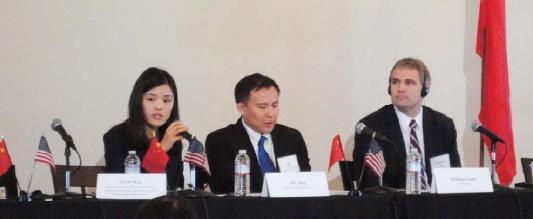
Moderator: Guo Wei, Department of Science, Education, Culture and Health, Legislative Affairs
office of the State Council
William Latta, LP Amina
Latta gave a brief background of LP Amina, a company founded in 2007 that is focused on
pollution control, with active projects in the U.S., China and Mexico. They have 100 full time
employees and up to 300 employees based on specific projects. Their technology includes NOX
abatement for coal fired power plants. They are active in R&D. The company has partnerships in
China, Germany and the U.S. to develop clean coal technologies, 1 of which is to the point of
commercialization. To commercialize this technology they are working under the CERC
platform, with the Chinese company Ge Meng based in Shanxi province (Taiyuan). Ge Meng
Electric Group is 47% owned by Shanxi Province, and the rest is owned by Korean Power and
Deutsche Bank.
He Jing: Beijing Anjie law firm.
He’s firm works with companies developing JVs in China. He said that one key issue in the
development of new technologies is a establishing a governance structure across the labs and
universities involved. He mentioned these joint research collaborations aren’t legal entities or
limited liability firms, so this is a problem when it comes to accountability. Another issue is
related to funding, and how firms allocate their resources across different stages and manage it
well. He discussed the problem in establishing initial agreements, particularly when firms hold
back valuable information prior to agreement being reached, but that this can breed a lack of trust
on both sides.
Latta elaborated on LP Amina’s JV in Shanxi. He mentioned that they have been active in China
since 2008, and have projects in 15 provinces working with coal plants across the country. As a
result they had a reasonable assessment of IP protection and some of the issues in China prior to
entering into their JV. He said that he believed IP protection is possible anywhere in the world,
but the ways to go about it in different contexts are different. He said that mutual understanding
between parties is key to be able to get to the real issues about how to set up a framework that
protects both parties’ interests. Their own JV agreement was established in summer 2012 and is
expected to be operational by summer 2013. While they are still in the early stages of their
collaboration, so far their IP strategy has proven robust. They constructed it by soliciting good
advice including from large MNCs, and by building on their past practices.

(LEFT TO RIGHT) HE JING AND WILLIAM LATTA
He Jing elaborated on the issue of non-patented proprietary
technology, including trade secrets. He explained that in the
process of creating the JV, very often both parties rely on NDAs
or other confidentiality agreements to create an environment for
both sides to share information about what know-how they have.
It is common for new/immature technologies for few patents to be
available. He referred to a recent amendment in China of the civil
procedure law (March 1, 2013) that now offers preliminary
injunction for contractual and trade secret cases. In the past,
Chinese law only permitted this for patent and trademark and
copyright cases. This allows companies to go to court to seek
injunction or ask for monetary damages. While he believes that there are still some real concerns
about enforcement and local protectionism, there are new legal tools available in the Chinese
context which may give more confidence to technology owners when they make their disclosures.
As a result, he mentioned that there are now several high profile trade secret cases among JVs
being litigated in the Chinese courts. While patent infringement cases are normally not between
business partners, in trade secret cases they often are. He said that the Chinese court (particularly
IP judges) is getting more experienced with IP cases, and therefore litigating in China may in
some cases be better than in the United States.
Latta explained that anytime you have to go back and reopen an initial partnership agreement
after it was already signed you are already in trouble. As a result, they spend a lot of time on the
initial negotiations, including rights for background and foreground IP, and
exclusive/nonexclusive rights of the JV to exploit the IP. Also important is the business strategy,
including management and board structure for how the JV will resolve disputes.
Also discussed on this panel were issues surrounding cultural differences, and how this may
influence differences in understanding terminology. For example, there is a different
understanding or concept of how the idea of exclusivity exists in China and in U.S. contract law.
Even the term “technology transfer” is understood in China to be a very broad concept, including
every form of technology cooperation, whereas in the United States it usually has a much
narrower scope. In addition, there are two types of exclusivity in Chinese law, applying to the
licensee as well as the licensor. It was suggested that cultural differences should inform visions
for the future of the JV, including how different types of disagreements would be worked out in
practice. Another cultural difference comes from perspectives brought to the table. For example,
it is in the nature of many Chinese firms not to think about worst cast scenarios, whereas U.S.
firms tend to be savvier on this point. It may be viewed as overly negative to talk about divorce
when you haven’t even been married yet, and therefore such discussions must be handled
delicately.
He Jing elaborated on the challenges in enforcing trade secrets in Chinese courts. He said that the
judge’s role is quite different from in the U.S. system in that they are responsible for conducting
the discovery process (including going to the factories, examining the data), which requires the
judges to be professional and willing to learn the technical details. It also may be difficult for a
plaintiff to enforce a trade secret if they do not want to disclose it in court, since confidentiality
agreements are rarely used. He believes that the courts are in fact working on this and that there
will be new policies implemented by the end of this year. He mentioned that there are 2-3 very
high profile cases pending in Chinese court and the results could be indicative of future trends to
come.
6. Panel 3: Case Study: Bringing IP from China to the United States
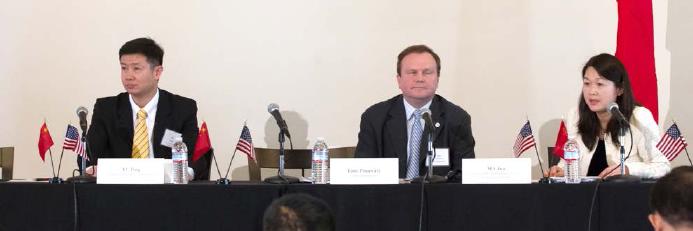
(LEFT TO RIGHT) PING YU, TONY POSAWATZ AND DR. MA JUN
Moderator: Ma Jun, Director of Tsinghua University’s Overseas R&D Management Office
The first case discussed was a partnership between Fisker Automotive and Jing-Jin Electric (JJE)
Technologies called Fisker Karma.
Ping Yu, Chairman & CEO, Jing-Jin Electric gave an overview of their product: the first luxury
electric vehicle (new energy vehicle) with extended range. Fisker makes the motors and this
involves a lot of technology and IP. JJE is a young Chinese firm which developed the eMotor for
Fisker Karma on their own, with co-investment from Fisker. JJE has benefited from a competitive
manufacturing structure and access to rare earth materials. The firms jointly market and sell into
market in other countries.
Tony Posawatz, CEO, Fisker Automotive, gave an overview of their strategy to take technology
from across the globe and bring it together to find a better way for it to solve the problems we all
have going forward. Fisker is a startup founded in Anaheim, CA 5 years ago, and after 4 years
they delivered their first car (The Karma) in the United States, EU and GCC. It will also be
launched in China at the Shanghai auto show, because they view China as a very important and
large market. He said that JJE has been a great supplier, and they expect them to bring
technology, quality and competitive cost. He said that they are willing to take risks, like Fisker, in
technology as well as legal relationships.
A key factor identified in the success of this partnership is that Tony and Ping Yu used to work
together at GM in the past, and as a result have a long-term relationship which has helped the
collaborations between their current firms. Other cultural similarities between the firms were
credited with the successful partnership. They were both financed by venture capital firms. Their
IP agreements were in line with industry norms, and negotiated by a major Detroit law firm that is
involved in most automotive contract law. Both partners also had a shared vision which also
helped the collaboration. They want to be leaders in electric vehicles and overcome the remaining
technical obstacles to the widespread use of EVs. They primarily invest in applied technology
(product engineering) rather than basic R&D, but as they grow they hope to be able to invest
more into basic R&D.
It was also mentioned that collaboration is crucial for the survival of small companies,
particularly if other firms bring IP infringement cases against them. Collaboration was also
identified as being crucial to driving down costs and sharing RD&D costs. Karma received a
DOE loan and has been looking for other partnerships due to the capital intensity of the auto
sector. Fisker looks for a variety of things when assessing new partners, including technology,
price, inherent capabilities (logistics and material control) as well as quality.
Dr. MA Jun, Director of the Overseas
R&D Management Office, Tsinghua
University

Ma Jun elaborated on how Tsinghua handles
international cooperation. She said that
Tsinghua has many international patent
applications and policies to encourage
technology transfer in part to cover the costs
of the patenting process. They also have
incentives in place to move R&D results from
the lab to commercial applications. For
example, if technology is transferred the team
will enjoy 40% of the income royalties. The team’s university department will also get 40%, and
the university takes 20%. The PI gets 50% of the 40% that goes to the team.
7. Panel 4: The Evolving IP Landscape in the United States and China

(LEFT TO RIGHT) ERIK R. PUKNYS, WANG HANPO, MARC COHEN AND HOU QIONGHUA
Moderator: Erik R. Puknys, Finnegan, Henderson, Farabow, Garrett and Dunner, LLP
Wang Hanpo, Beijing Huayi Law Firm, Hou Qionghua, MOST, and Marc Cohen, USPTO
engaged in a discussion about the evolving IP landscape in the United States and China. Wang
began with a presentation that included a timeline of IP protection law in the United States and
China as well as cooperation in this area. Hou discussed the inventor reporting system in China
that is being implemented to better determine ownership of patents and better rewarding
inventions. Cohen said that the U.S. PTO and SIPO relationship is robust, and includes ongoing
discussions on patent reforms as well as ways to streamline patenting processes in both countries
and a dialogue on the economic impacts of IP in our respective economies.
Issues raised by the panel include the differences in the discovery process in China and the United
States. The cost of discovery in the United States may mean it may be cutting back on discovery
while China is ramped up, and therefore there may be a middle ground. Evidence gathering
involving China is confusing for U.S. courts but on substantive harmonization we have made a lot
of progress.
Cohen mentioned that the United States looks to China and China looks to the United States as to
how to change laws. For example, he visited the Suzhou patent office when the United States was
opening satellite patent offices in order to see how China ran them. The United States is also
looking at China’s discovery process as it looks to reform the U.S. process. Hou mentioned that
China amended their own law based on the U.S. Bayh-Doyle act such that IP rights should be
granted to the institutions that actually did the R&D.
Also discussed was the matter of how to incentivize inventors, and how to measure patent quality.
Cohen said that SIPO uses the percentage of service inventions as a measure for quantifying
increased patent quality, because the more patents made in the service of an employer, the more
likely they are to be higher quality patents (particularly utility/invention patents). Overall the
percentage of non-service inventions in China is well in excess of the percentage of independent
inventors in the United States. Also mentioned was the problem faced by U.S. law firms in
researching Chinese patents due both to the large quantity of patents as well as well as language
barriers. Cohen also remarked on the dearth of U.S. law students being trained in Chinese law.
All panelists agreed that a lack of familiarity with each other’s systems was often the root of IP
concerns.
Wang mentioned that there are likely to be upcoming revisions to the copyright law in China.
However, he said that there would not be revolutionary changes to Chinese law, just incremental
changes.
8. Panel 5: IP in International Clean Energy Finance
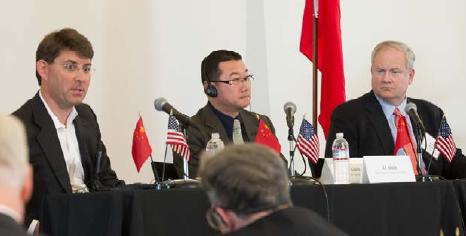
(Left to Right) Jeff BALL, LI Amin and Gary RIESCHEL
Moderator: Jeff Ball,
Stanford University
Gary Rieschel of Qiming
Venture Partners spoke
about his experience
investing in China in a
variety of sectors including IT, healthcare and cleantech (currently not clean energy but primarily
pollution control and energy efficiency technologies). His company is entirely Chinese nationals
and they’ve put together many joint ventures in China, as well as cross-border deals. They make
many early stage investments, many of which have IP concerns. He mentioned that China has a
lot of financing support for startups, including companies based off another company’s idea. He
brought up the example of Groupon, which he said had launched about 117 copycat firms in the
United States, and over 800 in China.
Li Aimin, of China Venture Capital Co. Ltd. Spoke about his company which was established in
2000. They invest $400 million, most of which comes directly from wealthy Chinese investors,
and is entirely invested in China. They focus their investments on conservation and new
materials, and invested $67.7 billion in the Chinese clean energy sector in 2012.
Rieschel said that LP Amina (discussed on a previous panel) is one of their investments. Others
include LanzaTech, which has a microbe discovered in New Zealand and brought to China in
2009 that eats carbon monoxide from steel mills and could be used to make useful products once
commercialized. Due to China’s role in global steel production, the owners of the technology
decided they needed to demonstrate their technology in China in order to bring it to
commercialization, but they were inexperienced and saw many barriers to making this happen.
They decided to start a joint venture with Bao Steel that involved 9 months of reasonable IP
negotiations. In this case the JV does not own the IP; Bao owns a 70% revenue and profit share of
the commercial product; LanzaTech 30%, and Bao pays LanzaTech a royalty scheme. The
microbes themselves could be reverse engineered, so they were provided in freeze-dried cylinders
in a way that prevents this. It took 18 months in total to negotiate the agreement. He also noted
that LanzaTech has another partnership with Capital Steel, and both Chinese JVs are competing
with each other to see who can commercialize the technology first.
Rieschel also mentioned Bloom Energy as another interesting case. The company makes a solid
oxide fuel cell and has made a huge investment to try to commercialize its technology. Initially
they opted not to bring it to China, but ultimately they decided they couldn’t get to commercial
scale without China. To manage IP they held onto the core IP in Silicon Valley, and source the
rest in China across multiple firms (so no single firm has the full “recipe” for the technology).
Segmenting suppliers was discussed as another model which can be effective for managing IP in
China.
Li mentioned that Chinese firms were not allowed to be publically listed if they had IP
infringement violations. He said that they look at the source of the core technology and whether
it’s being protected sufficiently before deciding whether to invest in the company. He also looks
for redundancy, and that there isn’t just one person that holds all the secrets in case something
happens to them.
Rieschel discussed the problem of U.S. firms that are looking to enter China frequently rushing
the selection of a partner, and that he has seen firms take less care in doing this than they would
with a partner in the United States. He emphasized the importance of spending time in China and
making sure there are common interests, nothing that these days there is no excuse not to do this,
and that laziness in partner selection and diligence leads to problems down the road.
Both firms were asked to mention the “coolest” technology they had invested in. Rieschel
mentioned that in the health care sector they were investing in a Chinese with a non-insulin
human injectable, noting that China has largest population of diabetics on the planet. Another
firm has a cochlear implant for people hard of hearing. Li mentioned a firm they had invested in
that addresses landfill runoff.
Rieschel suggested that China should in fact be the commercialization center for the world, and
that it may be wrong for China to focus on the invention (or “brutal early stage invention end”)
but rather should focus on how to become the best place in the world to commercialize
innovations.
9. Panel 6: Quiz the Lawyers - Business Leaders Seek Counsel

(Left to Right), LIU Yumin, William JACKSON, Professor YU Xiang, Dan LANG and
Dr. Benjamin BAI.
Moderators: William Jackson, Dow Chemical; Liu Yimin, GCL America
This panel consisted of a series of questions asked of the panelists: Benjamin Bai, Allen & Overy;
Dan Lang; Cisco Systems; and Yu Xiang, Huazhong University. The first question dealt with
establishing JVs in China. Bai recommended negotiating how the IP is owned prior to the
beginning of the JV, and ensuring the parent firms own the IP rather than the JV itself, in case the
JV gets dissolved down the road. He also recommended setting up a committee for IP
management. Regarding trade secrets, he recommended establishing an understanding between
yourself and the employees of the JV, otherwise you may not have standing to sue the violating
employees. He suggested a 3-way agreement between you, the Chinese partner and the JV itself.
Lang added that while it is hard to think about your JV not being successful it’s important to think
ahead.
The second question asked about whether to use patents or trade secret protection when dealing
with manufacturing process innovations, whether to patent or use trade secrets. Lang responded
that they must decide whether to seek patent protection, with the cost being public disclosure,
within 18 months. Costs often prohibit applying for patents in every country, and there is
variability in the strength of the patent systems in various countries. He referred to “prior user
rights” within patent law as a way to hedge bets with trade secrets. If someone else
simultaneously develops the same trade secret or files a patent off your trade secret, you can get
sued for something you invented but kept to yourself. This is one form of protection is weaker
than other aspects of IP law, and therefore this encourages people to file for patents over relying
on trade secrets. Yu Xiang added that a key element for CERC is setting up a way to mitigate the
risk of IP disputes among partners. In addition, it is important for any license agreement to detail
exactly what is being licensed.
William JACKSON, Dow Chemical
Company, comments as LIU Yimin listens.
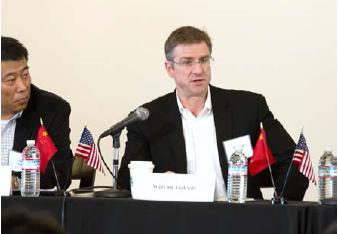
The third question raised the issue of
background IP, for example when a company
hires an employee that brings in expertise from
a previous position. Jackson mentioned that
frequently when employees bring secret
information to a new company that violates
trade secret protections or other internal
information, the new company does not want to
be sued so may be willing to cooperate where the employee is concerned. In a case of this
experienced by Dow, the company opted to terminate the employee and the manager was
punished, so that they could avoid a lawsuit. Bai added that sending a letter to the hiring
company noting that there is a problem gives them liability, so notifying them is important. He
agreed that most of the time companies will do the right thing once you initiate this process. He
added that non-compete clauses are generally hard to enforce in California, it they are valid and
enforceable in China for up to 2 years, and are in fact much easier than enforcing trade secrets.
Liu brought up the issue of “easy IP,” IP that can be easily copied. He noted that many small
companies are scared to bring “easy IP” to China, even if they may have meaningful applications
there (for example could make significant environmental impact). Both Bai and Yu noted that
easy IP cases are also easier to win in litigation, because it is easier to provide evidence and win
in court. Because of this, Bai said that he believed companies should always bring the best
technology to China. For patentable technology this is a “no brainer” because it’s already
published. For trade secrets, you usually still should, because you “don’t want the IP tail to wag
the growth dog.” He mentioned General Motors, saying that if GM did not take a leap of faith in
bringing its car technology to China it would not be where it is today. It’s not so simple that if
you bring your best technology to China you will lose it. You need to take special precautions.
And you can enforce simple designs more easily as previously mentioned. He noted that the win
rate in Chinese courts is about 80%. While this does not mean it’s easy to litigate in China, he
believes that if you persist and understand the system you can win. But, you do need to factor the
cost of IP enforcement into your business plan, because you will have infringement. Lang agreed
and said they have not had to hold back IP in their large R&D presence in China.
The panel then discussed the CERC’s TMP and how it affects company IP strategy in China.
Jackson said that the TMP was “pro-ownership” on behalf of the company doing the inventing,
and that the TMP offers a lot of comfort to companies that have joined the CERC. Yu added that
any new contracts signed between participants should follow the guidelines of the TMP.
10. Panel 7: Resolving IP Disputes in the United States and China
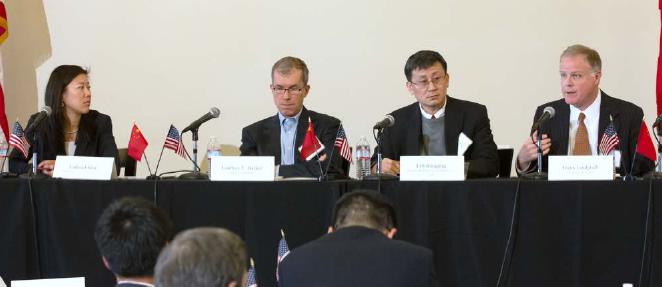
Left to Right: Professor Colleen CHIEN, Geoff BARKER, LIN Dongping and Frank LANDGRAFF
Moderator: Colleen Chien, Santa Clara law school.
For this session, panelists Frank Landgraff, GE, Lin Dongping, Mindray Biomedical Electronics
Co. Ltd., and Geoffrey Barker, RPX Corp., discussed how to resolve IP disputes in China and the
United States. Frank Landgraff from GE discussed how he has been on both sides of such
disputes as the plaintiff and the defendant. As most of his cases have been in the U.S. federal
district court, he expressed frustration with the U.S. discovery process and the associated costs.
He also noted that this process is much more costly today than a few years ago. He has also
participated in ITC process in the United States, which he noted was quicker than most federal
district courts in part because you initially try the case to an administrative law judge with good
patent expertise. He also mentioned that several new processes are being implemented at U.S.
PTO for patent litigation, and that the judiciary is taking note of these companies about cost of
discovery. For example, there is a patent pilot program in 14 district courts that allows specific
judges with patent expertise to take more cases.
Lin Dongping discussed a case that he was involved in where the company that infringed agreed
to settle and compensate for our loss. He said that he thinks, compared with U.S. administrative
proceedings, the Chinese system is more consistent. In the United States, as a startup company we
collaborated with GE and a big company in Japan. He said that their strong IP, in addition to the
fact that several lawsuits had ruled in their favor, positioned them well for strategic
collaborations. He noted that in China, the success rate for mediation is not that high, and it is
difficult to get companies in China to admit to infringement in front of the government. He
believes that administrative enforcement in China is quite effective and efficient on the whole.
However, he also said that the only way to win an IP infringement case is to outperform your
competitors, because you cannot win in court in China.
Lin also noted that patent filings in China are directly encouraged by the government, in that the
more patents you file the more subsidies you get from the government. He believes this is the
reason behind the massive growth in patent filings in China.
Geoffrey Barker recapped his professional history and how it has informed his experience with
patent litigation. At RPX, they buy license rights and all companies buy into their patent pool and
get the benefits of this. He said that since everybody is suing everybody these days, the only
people who are winning are the litigators. He believes that there is an opportunity within the clean
tech space has to learn from the experience within the communication technologies sector which
is experiencing an explosion of litigation. He mentioned that it is common for such companies to
have more than 50 cases on the docket at any given time. He noted that the clean energy sector is
seeing an explosion of patenting activity. However, many of these firms will ultimately fail, and
lots of patents will be released into the ecosystem, establishing a fertile ground for future
litigation. He suggested several options that could help to prevent this, including 1) increased
industry cooperation to deal with defensive patenting, such as buying up patents that pose
litigation risks to multiple companies and taking them off the market; 2) looking at a rational
model for cross-licensing to address overlapping patents, including establishing a way to
determine a methodology for adjudicating such overlaps, potentially saving the companies
involved extensive litigation in the future.
Regarding the issue of non-practicing entities (NPEs), Lin mentioned that NPEs cannot sue in
China without evidence of a loss of interest, and recommended that the U.S. system might
consider this. Barker noted that more and more NPEs are litigating in Germany.
The question of whether foreign firms can get fair treatment when litigating in a foreign venue
was raised, whether in the United States or China. Lin responded that firms should not be afraid
of litigating overseas, and that being a good corporate citizen is also important. Landgraff added
that often Chinese firms may not understand the U.S. legal process and this may lead to a belief
of not being treated fairly. The same scenario may be true for U.S. companies litigating in China.
Day 2
1. Welcome
Mary Elizabeth Magill, Dean of Stanford Law School, welcomed the participants for day 2 of the
conference, noting that this was the right place for this conversation to happen, and that we are
taking about the right issues.
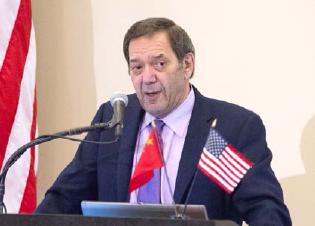 STAN BARER STAN BARER
Stan Barer, founding co-chair of the U.S.-China
Clean Energy Forum, also welcomed the
audience. He noted that IP is the confidence
builder for our engineers to develop the
technology we need to protect our planet for
future generations. He believes that the CERC
leaders share the vision that IP was important
enough to spend the last year planning this
conference. He thanked everyone for helping to make this very important process work.
2. Opening Keynotes

David SANDALOW. Acting
Undersecretary and Assistant
Secretary for Policy and International
Affairs, U.S. Department of Energy
David Sandalow. Acting Undersecretary
and Assistant Secretary for Policy and
International Affairs, U.S. Department of
Energy, opened the second day of the
conference. He had come directly from
the ARPA-E summit in Washington on
energy innovation, and noted that energy
innovation had been a major priority of
DOE and for Secretary Chu over the last
4 years. He said that the protection of IP
is a large part of what encourages innovation, and it has led to the creation of many companies
around the world. The United States has a thriving R&D industry that makes breakthroughs
because of a strong IP framework that encourages individuals to take risks, and allows others to
access their knowledge through legal means. He noted that while laws are important, they are not
enough, and that enforcement is necessary for IP protection.
Recalling the launch of the CERC, he said that it now provided a foundation for the U.S.–China
relationship. He said that the foundation for IP protection is strong and it provides a basis for
cooperative and productive work between our two countries that can be a model going forward.
He noted that what has been produced in the IP arrangement under the CERC is a great
achievement. He mentioned cyber security as well as a high profile ongoing IP dispute between
U.S. and Chinese wind companies, and called for a swift and acceptable for both sides.
Reminding the room about the key strategic relationship between the United States and China,
and the central role of energy and innovation, Sandalow said that we must leverage our strengths
in science and technology to make a better life for our people, and to build mutual respect.
When asked about the shale gas revolution, he said that it is having dramatic implications in the
United States and increasingly will around the world, and noted that DOE played an important
role in the 1970s and 80s in supporting R&D investments in hydraulic fracturing and horizontal
drilling technology. There may be technologies they are investing in today that could have the
same potential for revolutionizing global energy 20-30 years from now.
DR. JIN XIAOMING, DIRECTOR-GENERAL,
DEPARTMENT OF INTERNATIONAL
COOPERATION, CHINA MINISTRY OF SCIENCE
AND TECHNOLOGY

Jin Xiaoming, Director-General, Department of
International Cooperation, China Ministry of Science
and Technology, thanked the workshop sponsors, as
well as the government agencies, research institutes
and business community in the United States for
supporting CERC. He said that much progress has
been made since the launch of CERC. He called
CERC the most innovative collaborative R&D
agreement since the signing of the China-U.S. S&T
Agreement. He noted that the mid-term review
completed last month was successful, and that he expects that substantial progress can be
achieved in terms of knowledge, technology and commercial application. He encouraged new
business partners to join in the consortia.
Since 1979 when Deng Xiaoping visited the United States and signed the first U.S.-China S&T
Agreement, over 50 MOUs and agreements have been signed, and 14 bilateral S&T meetings
have been held. CERC joins these other bilateral frameworks in driving bilateral innovation
efforts, and he hopes that the CERC model can be expanded to other areas in the future, including
agriculture and health. He suggested future S&T activities for cooperation between the United
States and China including an innovation fund, an innovation park, an innovation research center,
and a technology trading market. He noted China had already established 10 national-level
innovation parks, each with a specific field or subject (including a U.S.-China collaboration in
Wuxi).
(Left to Right) David
SANDALOW and Dr.
JIN Xioming take
questions from the
audience.
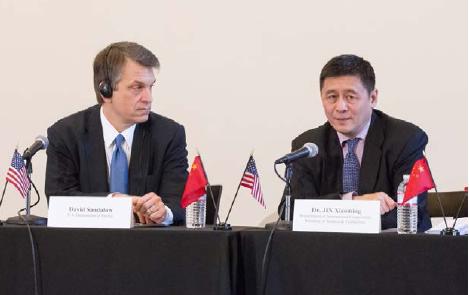
3. Panel 1: Tools for Capacity Building
(Left to Right) Pamela
PASSMAN and
Professor YU Xiang
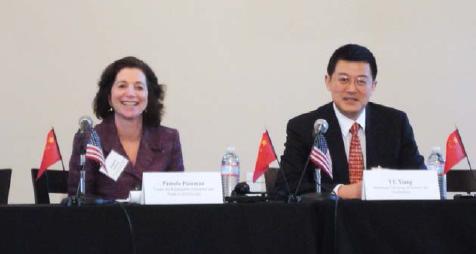
Pamela Passman. Center
for Responsible Enterprise
and Trade (CREATe.org)
spoke about her work
developing IP strategies for
companies. As the deputy
general counsel for
Microsoft for 15 years, she has come to appreciate the complexity of IP protection. She noted that
when it comes to IP protection, governments are key stakeholders, and that IP laws are
increasingly consistent around the world. Many large U.S. companies have spent decades
developing sophisticated systems to appropriately manage and use IP, which cuts across
numerous business functions (no just the lawyers). As an IP protection program matures, the
scope and risk assessment process can become broader and deeper, ideally across the supply
chain. This may include working proactively with supply chain members, and integrating IP
practices into contracts, as well as making IP protection part of due diligence for selecting new
partners and evaluating current partners.
She noted the issue of trade secret theft and there are specific actions companies can take to
manage it. Ongoing training and capacity building are needed so that employees and business
partners are aware of the rules and how to follow them. Continually improving IP protection
requires monitoring and measurement for levels of compliance. And when problems are
discovered, continual improvements across the organization should be made. Her company shares
leading processes for how companies do this with a three-step program. They are currently in a
pilot phase so are waiving fees to participating companies.
Yu Xiang, Huazhong University, suggested that a supportive government environment for
innovation is important, as well as capacity building and basic education on IP at all
universities—not just law schools—was important, and particularly in engineering and business
schools. He showed a model of a Swiss firm and now it incorporates IP management across the
firm. He noted that IP Strategy can also improve the competitive advantages of enterprises.
The speakers noted that every single company in the world must deal with trade secret theft or
piracy in some aspect of their supply chain. So it’s not a question of if this will happen but rather
how to manage it.
4. Panel 2: Trade Secret Tutorial
Moderator: Stacy Baird, U.S.-China Clean Energy Forum
Panelists Wang Hanpo, Beijing Huayi Law Firm, and Benjamin Bai, Allen & Overy, discussed
issues related to trade secret protection.
WANG Hanpo, Beijing Huayi Law Firm
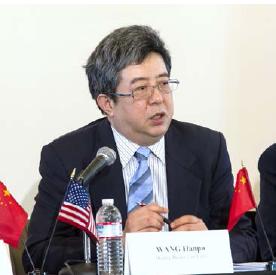
Wang’s presentation gave a history of China’s legal
system for trade secret protection, clarifying that trade
secrets protection has in fact been part of Chinese IP
law for a long time. He noted that the earliest form of
trade secret protection in China as in the 1980
regulation on joint ventures. 1993 was also an important
milestone for trade secret protection in China with the
launch of the unjust competition law. He noted that an
amendment to include protection of trade secrets has
been submitted but nothing has happened so far. He said
that the Chinese model for trade secret protection is gradually integrating with international
standards. He referred to trade secrets as hidden weapons of the IP innovation game.
Bai said that in the United States, trade secret cases are won about 40-50% of the time. In China,
not enough data for a meaningful conclusion, but he approximates 46-60%, and higher in some
second-tier cities. He also noted that of 60,000 IP cases filed, only 400-500 trade secret cases
filed. While the concept of a trade secret is the same in the United States and China (information
with some economic value subject to confidentiality measures) there are some differences in how
they are enforced. China does not have U.S.-Style discovery. And in the United States there is no
civil liability, only criminal, it is primarily handed at the state level. He also noted that in China,
oral testimony is acceptable but in practice it carries little to no weight. Evidence is primarily
written, but it must be the original documents—no copies. If you cannot show the original NDA
you do not even have a case. There is also a rule that in the United States you cannot withhold
adverse evidence, but not in China. In China it is important to create a paper trail in China to
protect your confidential information.
Dan Reicher, Executive Director, Steyer-
Taylor Center for Energy Policy and
Finance, Stanford University, poses a
question to the panel.
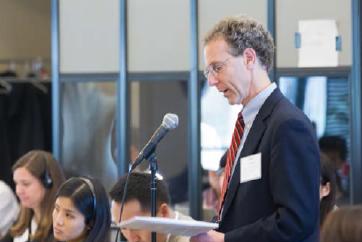
Bai suggested some best practices for
protecting trade secrets in China including
implementing and enforcing a trade secrets
policy; taking measures to guard secrecy;
using confidentiality agreements; obtaining
written acknowledgement for confidential information; employee education/exit interviews; and
building relationships with the police. He noted that the two most common ways trade secrets are
lost are emails and USB drives, so the simple solution is to disable your USB drives (this alone
will eliminate 50% of trade secret losses). While this may go against some corporate culture, it is
worth considering if your secret is important. He also suggested that companies monitor non-
work related emails, and have a warning system when there is an attachment in an email sent to
an outside company. Also recommended not immediately reassigning your laptops and computers
after an employee leaves so you’ll have evidence on hard drives and can establish a chain of
custody. Judges will want to see steps you have taken to protect your trade secrets so it is
important to have these in place.
Panel 3: Licensing Tutorial

LEFT TO RIGHT: DR. LIU SHAN, DR. MA JUN, DR. TOBY MAK AND LUIS MEJIA.
Moderator: Ma Jun, Tsinghua University
Panelists Liu Shan, Huazhang University, Toby Mak, Tee & Howe, and Luis Mejia, Stanford
University, discussed issues related to licensing IP.
Liu Shan noted that when licensing background IP you need to make sure you do not violate
China’s anti-unfair competition regulations, including when drawing up rights to license back
improvements to the background IP owner. For the CERC, participants should negotiate a non-
exclusive license in good faith terms in line with the TMP.
Toby Mak, Patent Attorney, Tee and Howe, said that technology transfer in and out of China is
governed by Chinese patent law and the “Administrate Regulations on Export and Import of
Technologies.” This covers not just patents but also trade secrets and copyrights. There are two
categories of technologies that require official approval by committee, including forbidden
technologies and restricted technologies. He also noted that there are different kinds of
exclusivity in a Chinese license: truly exclusive (also excluding the patentee) or only excluding
3rd parties (meaning the patentee is also allowed to practice the invention).
Mak noted that inventions completed in China must obtain clearance before filing for a patent
outside of China. If you fail to comply, your Chinese patent rights may be in danger (refused or
invalidated). Further, if you do this and the invention concerns national security, then criminal
charges could be involved.
Mak also pointed out some default clauses in Chinese agreements, which can be changed if
desired, that are generally not welcomed by business, for example default first-right-of-refusal to
inventor(s) when selling a patent, and co-owners of a patent can license the patent without each
other's consents.
Luis Mejia from the Office of Technology Licensing at Stanford University noted that licensing
with a university has more restrictions than with companies. Since most of Stanford’s research
support comes from the federal government, the Bayh–Dole Act applies. They primarily engage
in basic research, but if something comes out of it, the university then must decide whether to
protect that piece of IP. It may decide to file a patent application to help facilitate the transfer of
that technology. Exclusive licensing may be necessary to help that technology get
commercialized. Stanford has a process by which they market their inventions. Royalties will be
paid to the university and that will go to further the mission of the university. He noted that
licensing is difficult and takes a long time, and that energy technologies in particular require
significant capital for scaling.
Meija said that Universities generally own inventions made on campus jointly with collaborators,
and that the University wants to do what’s best for the technology, which is usually to transfer it
for public use and benefit. He noted that each university has its own royalty sharing rules. For
Stanford: 15% off the gross royalties offset licensing costs; then the remaining 1/3 of the royalties
to go inventors; 1/3 to the department; and 1/3 to the school. He noted that all universities
generally share royalties with the inventors.
5. Panel 4: Quiz the Lawyers – Researchers Seek Counsel
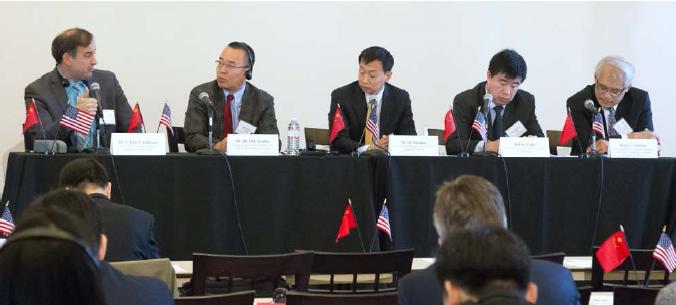
(LEFT TO RIGHT) DR. S. JULIO FRIEDMANN, DR. HUANG YUEHUI, DR. LU XIAOJUN,
DR. TIEFEI DONG, DR. ROBIN CHIANG
Moderators: Julio Friedmann, Lawrence Livermore National Laboratory; Huang Yuehui, Chinese
Society for Urban Studies.
The panelists, Lu Xiaojun, Tsinghua University; Tiefei Dong, University of Michigan; and Robin
Chiang, Lawrence Berkeley National Laboratory; answered questions from the moderators and
the panel on practical aspects of doing research in the CERC.
Friedmann noted that the value of cleantech is in deployment, and that while each CERC
technology area is covered by one protocol, the nature of the projects and the technologies are
different. This means that all the CERC participants likely think differently about how we make
partnerships and protect our inventors.
Several of the CERC participants noted their progress towards commercialization. Huang said
that they are working with LBNL in the buildings CERC and are trying to commercialize the
results of their research. Lu Xiaojun noted that the partners in the vehicles CERC are encouraged
to discuss the IP issues before the agreement is established. He said that each side has nominated
one party to represent the interests of the Chinese entities and one to represent the interests of the
U.S. entities, and they will manage the patent application process and licensing in each country.
Some concern was raised that this separation was not necessary under the framework of the TMP.
Robin Chiang noted that the determination of who owns the IP is based on the vendor in U.S.
law. He gave examples of how ownership over inventions would be determined within the CERC.
For example, if software is produced by Berkeley Lab, the lab would be the sole owner. But if a
Chinese company contributed code, the final product would be a joint work, so they would be co-
owners. The philosophy of the lab is that it is a non-profit, and so it does not commercialize their
inventions, and they make sure distribution is for the public good.
An example was given where a U.S. research university invents a solvent for CO2 capture. They
partner with a U.S. company that designs the reactor that retrofits power plants and the company
wants to demonstrate this technology in China. Through the CERC they identify prospective
companies to do this. What’s the best structure of an agreement to protect the IP? Dong
responded that they would first work with the U.S. company that has the reactor to see the field of
use of the solvent, and whether they should give a non-exclusive license to that company. Then
the U.S. Company should decide what’s in their best interest for the Chinese partnership as
relates to their strategy in the Chinese market. There would also be sublicensing language in their
agreement with the company in the case they decide they no longer want to be involved, so that
they can sublicense to a Chinese partner. This would be pre-defined and reflected in the original
license with the U.S. company. The agreement would likely also have clauses to make sure the
company actually takes steps to get the product on the market.
A question was raised about the CERC TMP, and how it allows for a U.S. party to license in
China or vice versa, such that inventors are not restricted to license only in their own country.
Such a restriction would revert us back to the S&T agreements we’ve been operating under for
the last 30 years. Lu noted that it was often simpler for the local party to handle the local market
in which they are familiar, and to evaluate the IP strategy within that region. Dong explained that
in their joint IP management plan with Tsinghua and Michigan, each side gets options for IP from
the other side, but they needed a default to refer to when issues over IP arise and focal points on
each side to address this. Dong noted that the parties involved in the CERC still have a say in
how the patent will be filed.
6. Panel 5: CERC Clean Energy IP Update

(LEFT TO RIGHT) STACY BAIRD, AND PROFESSOR YU XIANG
The final panel of the conference featured Stacy Baird and Yu Xiang giving an update on the
CERC’s IP program. Baird said that they were in the process of producing a joint handbook for
the CERC teams based on the widely adopted University of Michigan IP handbook to address IP
and technology transfer in the United States and China. The handbook describes the law in non-
legal jargon and provides guidance for SMEs and researchers for how to address various issues.
In addition, the U.S.-China Clean Energy Forum has put together a new website and blog that
aims to connect the CERC participants with useful IP information: http://ipknowledge.org/.
They have also developed a CERC IP Experts Group under MOST and DOE to identify real IP
issues among CERC participants and develop solutions to those issues. This group will conduct
interviews and surveys to understand the needs of the CERC participants and identify potential
solutions to the problems. They expect that this will include everything from enhancing
confidence in doing joint research to enhancing innovation, as well as clarifying legal relations,
IP education, and providing appropriate consulting services. Yu asked the researchers within the
CERC to identify any challenges they are facing with respect to IP and approach the experts
group with questions.
7. Closing Summary and Dialogue
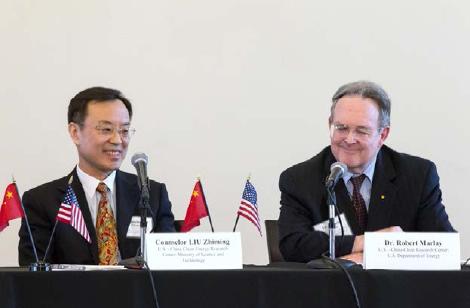
(LEFT TO RIGHT)
COUNSELOR LIU
ZHIMING, AND DR.
ROBERT MARLEY
Liu Zhiming, China CERC
Director, and Robert
Marlay, U.S. CERC
Director, concluded the 2-
day workshop with their
thoughts on progress to date
and remaining issues to address.
Liu said that great progress had been made under the CERC framework, and that these past two
days of discussion of both the legal framework as well as real cases have been very conducive to
building further collaboration and mutual trust. He noted that from the Chinese side of the
partnership he thinks that there is a lot of sincerity, friendship and collaboration and that the
CERC is a win-win situation. He was happy to hear about examples of IP transfer from the
United States to China and from China to the United States, and about issues and problem and
how to solve them. He said that he is glad that the CERC has become a platform for good
communication and promoting mutual understanding, which is extremely important. He believed
that both sides have heard things from how the other country deals with IP issues that may be
helpful as reforms are considered.
Liu also noted that we heard about several cases in which IP disputes between United States and
Chinese companies were settled, and that this should give us confidence that there are ways to
successfully resolve IP disputes. He urged the CERC participants to explore ways of solving
problems. He also hopes that the CERC can serve as a model for IP protection in future
collaborations between the two countries beyond clean energy in the future.
Marlay agreed with Liu’s remarks, and focused his remarks on options for moving forward. He
asked whether it would be useful to hold another IP conference, and what we would want to
complete between now and then. He noted that the process of negotiating sub-agreements under
the TMP has only just begun, and that if R&D progresses into more applied phases (which he
noted was certainly already happening in the coal CERC) that the tools being developed to help
with these negotiations may be very useful. He also noted that their goal is to educate the CERC’s
engineers and researchers without burdening them.
In terms of additional things to work on, he noted that they are just a small program and only a
piece of the bigger IP protection problem, yet these things are extraordinarily serious. He asked
participants to identify key issues to work on. For example, can we develop streamlined online
application processes for U.S. companies to use when licensing in China? He also noted that the
experts group might be a useful place for researchers to go when they have questions, and noted
that he would work with Counselor Liu to discuss how this might best function.
Marlay asked for members of the audience, including the CERC directors, to discuss their ideas
for moving forward.
Stacy Baird noted that it may be useful to develop a set of best practices, because while there are
lots of issues and they often sound daunting, in fact they manageable and everyone at the
workshop is in the business of getting things done in this area. He emphasized that the issues that
arise are dwarfed by the enthusiasm and desire to do the transaction.
Huei Peng (Vehicles CERC- U Michigan) noted that they are in the process of disclosure for 23
inventions from the Chinese side and 9 from the U.S. side. The CERC-V already has many ideas
that they are seeking protection for through patent filings.
Jerry Fletcher (Coal CERC-U West Virginia) said that when they initially got involved he was a
bit surprised that IP issues would need to be dealt with in such depth. But he is now confident that
there are advances that allow us to address these concerns. He also said that he believes what they
are doing will spillover far beyond the CERC in its impact.
Nan Zhou (Building CERC – LBNL) noted that while in phase 1 they were primarily in the
analysis phase, they have now shifted more to innovation and knowledge generation so IP has
become much more essential. She believes that case studies and tool kits are very helpful, and is
glad to have access to an expert group. She noted that the Buildings CERC has an active
industrial advisory board and the companies are very involved in this. She mentioned a few key
projects, including Dow Chemical developing cool roofing materials together with our national
labs, and a new Chinese partner, Lutron (路创), developing lighting control systems and
algorithms with LBNL. Going forward she noted they will need to learn more about IP issues in
order to have successful collaborations.
Bill Jackson noted that it would be interesting to see an example of successful cross licensing and
IP dispute resolution within the CERC. He noted that someone will get there first and that it
might be valuable to put together a candid case study of how that went that could be shared across
the team. He noted that he believed there would be at least one example between now and the
next IP conference.
Griff Thompson of the U.S. Department of State noted that it we could do a better job of
communicating the success of this program within other agencies. He said that anything we can
do to break through the fog of misunderstanding will be very beneficial to both governments. He
noted that having these successes communicated would be a huge advantage and contribution to
breaking down those barriers.
|
|
 |

